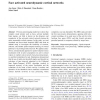Free Online Productivity Tools
i2Speak
i2Symbol
i2OCR
iTex2Img
iWeb2Print
iWeb2Shot
i2Type
iPdf2Split
iPdf2Merge
i2Bopomofo
i2Arabic
i2Style
i2Image
i2PDF
iLatex2Rtf
Sci2ools
MBEC
2011
2011
Face activated neurodynamic cortical networks
Previous neuroimaging studies have shown that complex visual stimuli, such as faces, activate multiple brain regions, yet little is known on the dynamics and complexity of the activated cortical networks during the entire measurable evoked response. In this study, we used simulated and face-evoked empirical MEG data from an oddball study to investigate the feasibility of accurate, efficient, and reliable spatio-temporal tracking of cortical pathways over prolonged time intervals. We applied a datadriven, semiautomated approach to spatio-temporal source localization with no prior assumptions on active cortical regions to explore non-invasively face-processing dynamics and their modulation by task. Simulations demonstrated that the use of multi-start downhill simplex and data-driven selections of time intervals submitted to the Calibrated Start Spatio-Temporal (CSST) algorithm resulted in improved accuracy of the source localization and the estimation of the onset of their activity. Loc...
| Added | 16 Sep 2011 |
| Updated | 16 Sep 2011 |
| Type | Journal |
| Year | 2011 |
| Where | MBEC |
| Authors | Ana Susac, Risto J. Ilmoniemi, Douglas Ranken, Selma Supek |
Comments (0)

